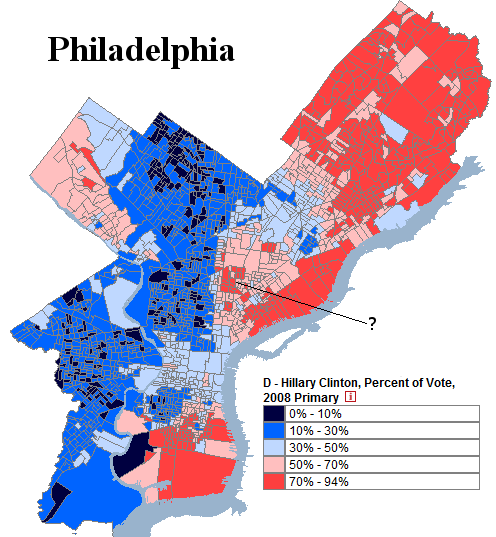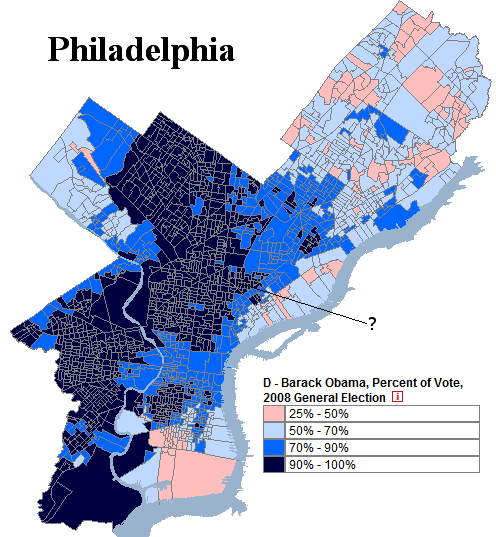A long time ago, I posted a series of posts analyzing the swing state Pennsylvania. One section of this series focused specifically on the city of Philadelphia. This section analyzed Philadelphia’s vote by precinct results and mapped out the results of several previous elections.
Of particular interest was the difference between the results of the 2008 presidential election and the 2008 Democratic primary, which illustrated a political divide not seen in presidential elections: between Democratic-leaning white Catholics in the northeast and Democratic-voting blacks in the west.
Here is Philadelphia in the 2008 Democratic primary. Take a note at the region the question mark points to, which this post will discuss:
More below.
(Note: Both images are taken from a website which maps historical Philadelphia election results.)
Here is Philadelphia in the 2008 presidential election:
Most of the different voting patterns between these two elections is fairly easy to explain: blacks in west Philadelphia voted for Barack Obama both times, while white Catholics in the northeast voted strongly for Hillary Clinton in the primary and then lukewarmly Barack Obama in the general election. There is generally a scaling relationship between the two groups: as an area gets more white and less black, its support for Mr. Obama decreases in both elections.
There was, however, a group of precincts in Philadelphia which did not follow this model. These precincts are marked by the question mark in both maps. This group behaved quite strangely. It gave incredibly strong support to Ms. Clinton in the primary and then even stronger support to Mr. Obama in the general election. In the map of the 2008 primary, a number of these precincts cast more than 70% of their ballot to Ms. Clinton. All of them then vote more than 90% Democratic in the general election.
This behavior was quite puzzling, and something that the model did not explain. Initially this author hypothesized that these voters were white liberals in gentrifying areas of Philadelphia and then eventually forgot about the mystery.
The answer, as it turns out, was not white liberals. Here it is:
The mysterious precincts were Hispanic!
The above image was created using Daves Redistricting Application. Due to the tremendous efforts of David Bradlee, one can map the ethnic composition of every state in incredibly detail.
This provides some interesting insight into the behavior of Hispanics in inner-cities. If what holds for Philadelphia also holds for other cities (which is not a 100% certainty), inner-city Hispanics strongly supported both Hillary Clinton and then Barack Obama.
It is an insight provided by Daves Application which can be extended to many other areas and groups.
–Inoljt



I enjoy looking at these maps.
Hillary Clinton was also able to pull off a narrow win in Charlie Rangel’s Harlem Congressional district.
This reminds me of my GIS class. Extracting meaning from spatial data is extremely cool.
I wonder whether the handful of dark red/royal blue precincts in the northeast corner are also heavily Hispanic.
Not all Hispanic groups are the same.
Any Senator who represents New York is going to have inroads in the Puerto Rican community, which IIRC is the largest part of the Hispanic population in Philadelphia as well as in NYC. You can see the same pattern among New England’s Hispanics, for the same reason.
Note, however, that this phenomenon did not happen in the “Potomac Primary” where Hillary got clobbered, and Obama did well in neighborhoods in MD, DC, and VA that have large Hispanic populations – they were a major reason Hillary did little better in northern Virginia than she did in the Maryland suburbs despite the relative lack of African-Americans in NoVA. This is because the Central American community, the biggest group of Latinos in the DC metro area, was much less committed to HRC.
In a general election, the difference between these communities is not especially large (both groups are, when they vote, about as reliable for Democrats as you can get) but the differences can really show up in Dem primaries.
Don’t be surprised in ward leader endorsements played a big role here. That’s Angel Cruz’s turf.
Don’t be surprised in ward leader endorsements played a big role here. That’s Angel Cruz’s turf.